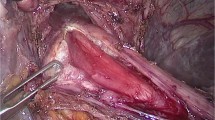Abstract
Background: Albeit rare in children, achalasia is a disorder with severe symptoms that causes growth impairment. The treatment of choice in children is the esophagomyotomy, although there are variations in the surgical approaches available and differences of opinion regarding the inclusion of an adjunctive antireflux procedure. The recent advent of the laparoscopic approach has had a profound impact on the treatment of achalasia in both adults and children.
Methods: In this report, we describe eight patients with severe achalasia who were treated by laparoscopic Heller's operation associated with a fundoplication according to either Dor's or Toupet's technique. The patients' ages ranged between 2 and 13 years. A five-port technique was used: a 10-mm port placed infraumbilically for the optics and four 5-mm ports. One was placed in the right abdominal quadrant for retraction of the left hepatic lobe, one in the left abdominal quadrant for the first operative instrument, one below the xyphoid appendix for the second operative instrument, and the last one to introduce a 5-mm cannula laterally to the umbilicus to retract the stomach below. A 7–8-cm laparoscopic Heller esophagomyotomy was completed, followed by an anterior Dor fundoplication in six cases and a Toupet in two. The longitudinal division of the anterior esophageal musculature was performed with a scalpel or scissors. The myotomy was made along the stomach, extending for ≥2–3 cm.
Results: Mean operating time was 120 mins. Three complications were recorded. There were two perforations of the gastroesophageal mucosa; the first was sutured in laparoscopy and the second required a second operation. The third complication was a case of dysphagia resolved by dismounting a fundoplication that was too tight. At follow-up, which lasted from 6 months to 5 years, the children were all free of symptoms.
Conclusions: Laparoscopic Heller esophagomyotomy appears to be a complex and difficult operation, but it is as safe and effective as laparotomy in children with achalasia. However, complications can be numerous and severe at the beginning of a surgeon's experience.
Similar content being viewed by others
Author information
Authors and Affiliations
Additional information
Received: 20 October 1998/Accepted: 19 April 1999
Rights and permissions
About this article
Cite this article
Esposito, C., Cucchiara, S., Borrelli, O. et al. Laparoscopic esophagomyotomy for the treatment of achalasia in children. Surg Endosc 14, 110–113 (2000). https://doi.org/10.1007/s004640000077
Published:
Issue Date:
DOI: https://doi.org/10.1007/s004640000077




